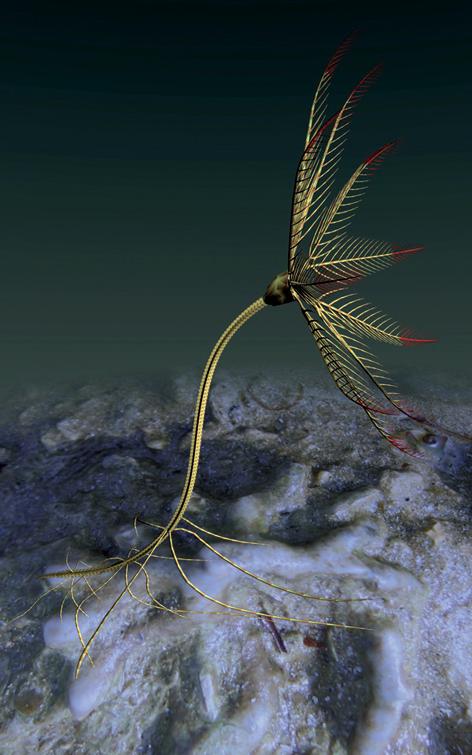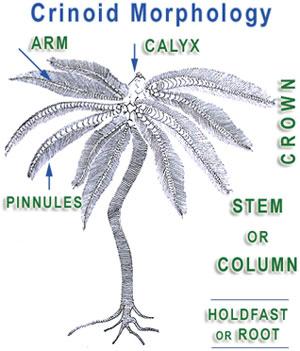Stars of Sion - Les étoiles de Sion
ENGLISH
The "stars of Sion" are fossilized marine
animals fragments also called Crinoids or sea
lilies.

Crinoids make up the class Crinoidea of the
echinoderms (phylum Echinodermata) and appeared here 420 million
years ago when the entire Lorraine region was still a hot sea.
Actually, there are only a few hundred known modern forms, but
crinoids were much more numerous both in species and numbers in the
past. Some thick limestone beds dating to the mid- to
late-Paleozoic like the hill of Sion where this cache is placed
are almost entirely made up of disarticulated crinoid
fragments. It is thus easy (and allowed) to scratch the
ground with your hands to find them.

Crinoids are typically characterised by their
radial symmetry. The three main parts of the crinoid are :

-The Calyx: contains the vital organs of the
animal and is devoted to food collection. The mouth and anus are
located on the upper surface of the body, and are connected by a
simple gut.
-The Arms: are composed of a articulated
series of ossicles that are used for feeding and respiration.
-The Stem: supports the animal and together
with the roots and cirri served as a means of attachment to the sea
bed or other substrate.
An Earth cache is not a normal cache. There is
no box hidden and you can only log this cache if you follow the
guidelines below:
Please send an email with the answers (via
the link to our profile at the top of the page) corresponding to
the following questions and wait for our positive feedback
before logging as “found it”:
Question 1: What are the sub classes
of the Crinoid in the scientific classification?
Question 2: What period of the
Paleozoic era corresponds to the apparition of the
earliest known crown-group of crinoids?
Question 3: What is the approximate
diameter of a "star of Sion" ? (You can either find it directly
by finding and measuring a "star of Sion" at the cache
coordinates or go to N 48° 24.559 E 006° 04.196 to find
this information)
Please attach a proof of your visit on the
spot when you log this cache. A picture of you with a "star of
Sion" in your hand is optional but would be appreciated
 .
.
Happy geocaching- Jeremysme & laulau54
FRANCAIS
Les étoiles de Sion sont des fragments de fossiles
d’animaux marins également appelés encrines ou
crinoïdes.
Les crinoïdes appartiennent à la classe
Crinoidea des Echinodermes (phylum Echinodermata) et sont
apparus il y a environ 420 million d'années quand la région
Lorraine était une mer chaude. Il n'y a actuellement plus que
quelques centaines d'espèces connues mais les crinoïdes ont été
auparavant beaucoup plus nombreux aussi bien en nombre d'espèces
qu'en nombre d'individus. On trouve les crinoïdes fossilisés dans
les larges couches calcaires datant du milieu jusqu'à la fin de
l'ère Paléozoïque comme le plateau de Sion où se trouve la
cache. Il est donc facile (et autorisé) de gratter le sol
pour les trouver.
Les crinoïdes sont typiquement identifiés par leur
symétrie radiale. Les 3 parties principales d’un crinoïde
sont :
-Le calice : contient les organes vitaux de
l’animal et sert à collecter la nourriture. A noter que les
lèvres et l'anus sont localisés sur la partie supérieure du corps
et sont connectés par un simple intestin
-Les bras: sont composés de segments
articulés qui sont utilisés pour la recherche de nourriture et la
respiration.
-La tige: supporte l’animal et sert,
avec les racines, de point d’attache au fond de mer ou au
substrat.
Une Earth cache n'est pas une cache normale.
Aucune boite n'est cachée et vous ne pouvez loguer la cache qu'en
suivant les principes suivants :
Veuillez envoyer un email avec les réponses
(via le lien vers notre profil en haut de page) correspondant aux
questions suivantes et attendez notre réponse positive pour
vous loguer en “found it”:
Question 1: Quelle sont les
sous-classes (ou ordres de rang inférieur) du crinoïde dans
la classification scientifique ?
Question 2: Quelle période de l’ère
du Paléozoïque correspond à l’apparition des
premiers groupes connus de crinoïdes ?
Question 3: Quel est le diamètre
approximatif d'une "étoile de Sion" ? (Vous pouvez soit
trouver et mesurer une "étoile de Sion" aux coordonnées
de la cache ou aller à N 48° 24.559 E 006° 04.196 pour
trouver cette information)
Merci de joindre une preuve de votre visite
sur le site lors de votre log. Une photo de vous avec une
"étoile de Sion" dans la main sera fortement appréciée
 .
.
Bon geocaching- Jeremysme & laulau54

